PRODUCTS
Corn whole growth period solution
Corn whole growth period solution
1. Corn Growth Stages
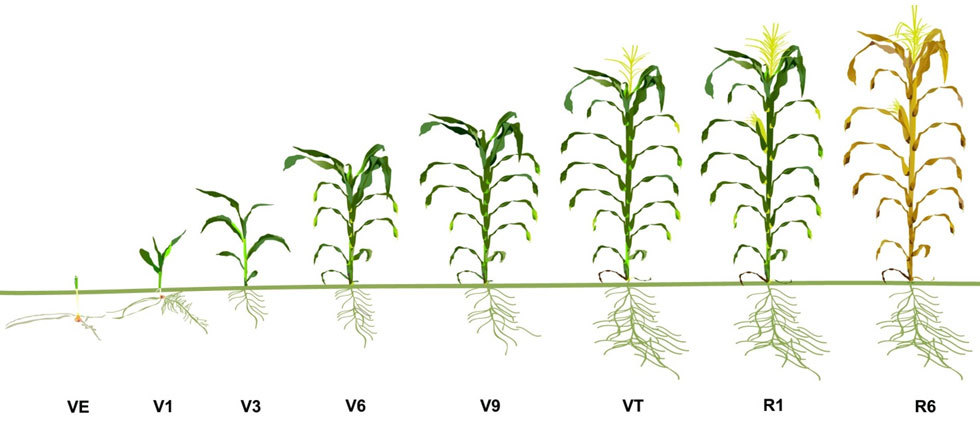

| Description | ||
|
VEGETATIVE STAGES |
VE | Emergence – shoot (coleoptile) has emerged from the soil |
|
|
First leaf – lowest leaf has a visible collar; this leaf has a rounded tip | |
| V2 | Second leaf – two of the lowest leaves have a visible collar, the second and subsequent leaves have pointed tips | |
| V(n) | nth leaf – “n” leaf collars present, most corn hybrids produce between 18 to 21 leaves | |
| VT | Tassel – lowest branch of the tassel is visible | |
|
REPRODUCTIVE STAGES |
R1 | Silk – one or more silks extends outside of husk leaves |
| R2 | Blister - kernels resemble “blisters” with clear liquid | |
| R3 | Milk – kernels filled with “milky” fluid | |
| R4 | Dough – inside the kernels are a “doughy” consistency | |
| R5 | Dent – dent forms on kernel and milk line progresses towards kernel tip | |
| R6 | Physiological maturity – kernels at maximum dry matter accumulation; a “black layer” will form at kernel base (2-3 days after physiological maturity) |
2. Corn Whole Growth Period Management
| Planting | VE | V3 | V6 | V7-V12 | VT-R5 | R6 | ||
| Diseases | Bakanae disease | fludioxonil,metalaxyl-M,chlorothalonil.Common seed dressings. | / | / | / | / | / | / |
| Dwarf disease | / | / | / | / | / | / | ||
| Northern/Southern corn leaf blight | / | / | / | / | / | Triazole compounds such as difenoconazole, propiconazole, carbendazim, pyraclostrobin and tebuconazole. | ||
| Stalk Rot | Triadimefon, Tebuconazole | Common protective fungicides such as mancozeb, thiophanate-methyl, and zineb | / | / | / | / | / | |
| Head Smut | Seed dressing (other control measures are the same as stalk rot) | |||||||
| Curvularia leaf spot disease | ||||||||
| Sheath Blight | Thifluzamide, Epoxiconazole, Difenoconazole, Hexaconazole, Jinggangmycin, Tebuconazole, Propiconazole, Pyraclostrobin | |||||||
| Rust | Triazole compounds such as difenoconazole, propiconazole, carbendazim, pyraclostrobin and tebuconazole. | |||||||
| Pets | Corn borer | Emamectin benzoate, Indoxacarb, Chlorantraniliprole, Methoxyfenozide, Hexaflumuron, Chlorbenzuron, Lufenuron, Abamectin, Spinetoram, Spinosad | ||||||
| Weeds | Weeds | Atrazine + Acetochlor EC, the control of malignant weeds needs to be mixed with 2,4-D-butyl ester 72% EC. Acetochlor+atrazine SC, propisochlor+atrazine SC, butachlor+2, 4D+atrazine SC | Nicosulfuron + Atrazine | |||||
3. Corn Disease, Pests and Weeds
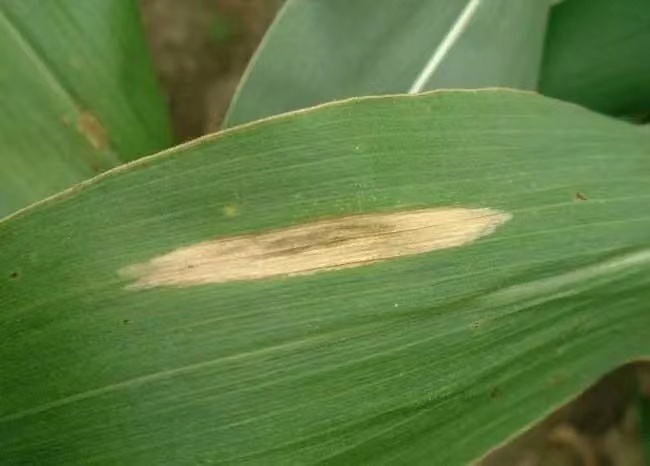
Northern Corn Leaf Blight
Symptoms
The tan lesions of northern corn leaf blight are slender and oblong tapering at the ends ranging in size between 1 to 6 inches. Lesions run parallel to the leaf margins beginning on the lower leaves and moving up the plant. They may coalesce and cover the enter leaf. Spores are produced on the underside of the leaf below the lesions giving the appearance of a dusty green fuzz.
Conditions Favoring Disease
If lesions begin early (before silking), crop loss can result. Late infections may have less of an impact on yield. Northern corn leaf blight is favored by wet humid cool weather typically found later in the growing season. Spores of the fungus that causes this disease can be transported by wind long distances from infected fields. Spread within and between fields locally also relies on wind blown spores.
Prevention and control
1. Use of resistant varieties; 2. Reasonable dense planting, increase application of organic fertilizers and phosphorus and potassium fertilizers; 3. Apply carbendazim 50% WP 500 times at the early stage of disease or thiram + ziram + urbacid 50% WP 800-1000 times, or thiophanate-methyl80% 800-1000 times, 50-75 kg of liquid per mu, spray once every 7-10 days, 2-3 times in total.

Southern Corn Leaf Blight
Symptoms
Common lesions are elongated, tan lesions between veins on leaves. Different isolates of this pathogen will cause lesions of different sizes. Race O causes long, tan, lesions that have brown borders on leaves. Lesions will develop differently on various inbreds and hybrids.
Conditions Favoring Disease
Overwinters in corn residue. Especially prevalent in areas with a warm, humid climate. Monoculture and reduced tillage.
Prevention and control
1. Use of resistant hybrids; 2. Crop rotation; 3. Tillage may be helpful; 4. Apply carbendazim 50% or thiophanate-methyl 70% WP 500 times, or mancozeb 90% 800 times, 50-75 kg of liquid per mu, spray once every 7-10 days, 2-3 times in total.
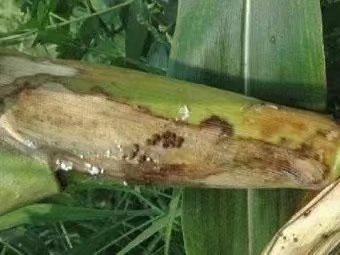
Corn Sheath Blight
Symptoms
Mainly infect corn leaf sheaths, the lesions are round or irregular, light brown, water-soaked, with fuzzy borders, the lesions expand and merge into large moiré-like patches, and the middle is light khaki, brown edges. In high-humidity climates, lush mycelium appeared in the lesions, and then formed into small white fluff balls, which gradually turned into brown sclerotia. Conspicuous moiré-like lesions sometimes appear on several nodes at the base of the stem. The stems of diseased plants are soft and disintegrated.
Conditions Favoring Disease
Overwintering with sclerotia in the soil, infecting corn in the second year, the disease first occurs on the leaf sheath at the base of the corn stem, and gradually develops upward and around. Generally, the disease begins at the jointing stage of corn, the disease develops rapidly in the tasseling stage, and the disease is severe in the silking and filling stage. Monoculture, high density, humidity, poor ventilation and light are more conducive to the development of the disease.
Prevention and control
1. Use of resistant varieties; 2. Reasonable fertilization, avoid excessive application of nitrogen fertilizer, reasonable irrigation and drainage, reduce field humidity, and improve disease resistance. In the early stages of onset, the disease can be alleviated by removing the diseased sheaths from the lower part of the corn plant. 3.At the initial stage of the disease, 100-150 ml of Jinggangmycin 5% AS or 25 g of Jinggangmycin 20% SP per mu is sprayed with 50-60kg of water.
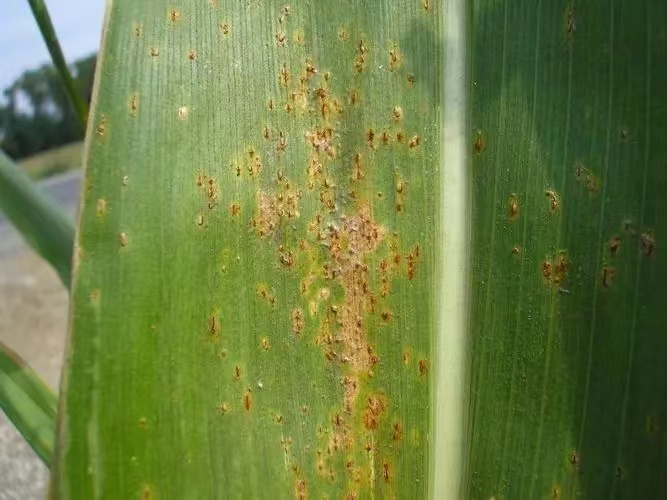
Corn rust
Symptoms
It mainly occurs on the leaves, with scattered or aggregated growth circular, yellowish-brown, powdery lesions on both sides of the leaves, and rust-colored powders are scattered, that is, the uredinia and uredospores of the pathogen. At the later stage of growth, round black telium and teliospores grow on the lesions.
Conditions Favoring Disease
Unlike most other foliar diseases of corn, this rust fungus does not overwinter in crop residue. Spores must be blown northward during the growing season (from mid-June to mid-July) from subtropical and tropical regions where this fungus survives on corn or wood sorrel, the alternate host. Young leaves are generally more susceptible to infection than older leaves. Rust development and spread are favored by prolonged periods of cool temperatures ranging from 16℃ to 25℃ and high relative humidity. Under these conditions, pustules develop on susceptible corn hybrids and sweet corn varieties within 7 days after infection.Occasionally, chlorosis and death of the leaves and leaf sheaths occur when infections are severe. Uredospores produced during the season are wind disseminated, spreading the pathogen to new leaves, plants and fields. As the corn plant matures pustules turn brownish-black in color due to the development of darker pigmented telia that replace uredinia and produce teliospores.
Prevention and control
1. Use of resistant hybrid varieties; 2. Rational fertilization and application of phosphorus and potassium fertilizer; 3. Spray difenoconazole, propiconazole, carbendazim, pyraclostrobin, tebuconazole at the initial stage of the disease, and spray once every 15 days for the severe disease.
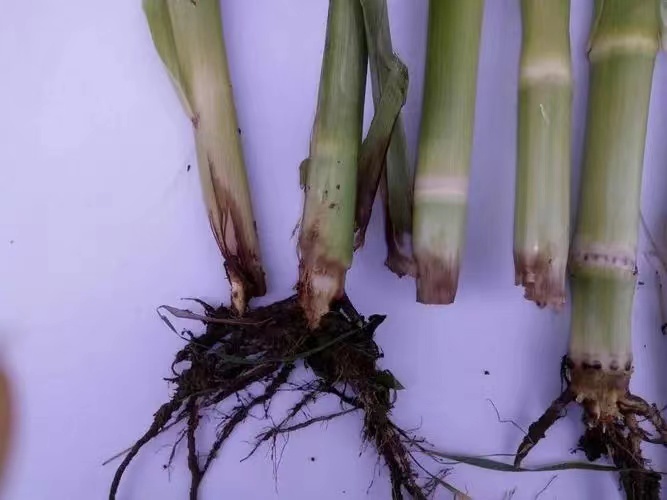
Corn Stalk Rot
Symptoms
The symptoms are more obvious during the milk-ripening to wax-ripening period. Generally, it gradually expands upwards from the lower leaves. Some diseased plants appeared acute symptoms after rain, and the whole plant become discolored. The base of the stem of the diseased plant becomes soft, the interior is hollow and loose, and it is easy to collapse in the wind. Inside the stalk,decay causes discoloration of the inner pith tissue which pulls away from the stalk ring leaving a weakened hollow tube filled with detached strands of vascular bundles.
Conditions Favoring Disease
The main sources of infection are diseased plant residues, soil and infected seeds. The overwintering fungus infects the root system after sowing to the tasseling stage, and then spreads and expands in the plant. The climatic conditions (especially rainfall) from grain filling to maturity are closely related to the disease, and high temperature and humidity are conducive to it.
Prevention and control
1. Select resistant inbred varieties, reasonably fertilize and dense planting to enhance the disease resistance of corn. 2. Crop rotation. Plough the soil deeply, remove the residue of diseased plants, and fully ferment the straw to reduce the source of soil bacteria.

Corn borer
Symptoms
The adults are yellowish to light tan in color. They have several dark zigzag marks across the wings, and their wingspan is 3/4 to 1 inch. During the day, adults take shelter in grass, weeds, and crop residue in and around crop fields. Adults are most active during late evening. The eggs are usually glued to undersides of leaves, in small irregular-shaped clusters that are white and very flat, containing about a dozen or more individual eggs. Clusters resemble fish scales overlapping one another. Each egg is about half the size of a pin head. After 3 to 5 days, the eggs change from white to a yellowish color, and then, just before hatching, a dark spot appears in each egg.
The larvae are dirty white, often having a pinkish tinge. The skin is smooth and free of hairs.There are numerous dark spots scattered over the sides and top of the body. The head is dark brown to black. It is the larval (borer) stage that causes damage to crops.
The pupal stage of the corn borer is rarely visible. Pupae remain inside the host plant, and adults emerge in late spring and in July. The pupae are smooth, light to dark brown in color, and 1/3 to 5/8 of an inch in length.
Life cycle
Fully grown larvae pass the winter concealed in corn stubble or other plant parts on which they have been feeding. When mature, the females begin laying clumps of white eggs on the undersides of the lower leaves of host plants. (Adult females may lay up to 500 eggs over their short lifetime.) Under ideal conditions, these first generation eggs hatch within 3-7 days. Tiny caterpillars begin feeding on host plants and complete their development in 3-4 weeks. Pupation occurs deep inside the corn stalks and second generation moths emerge and begin laying eggs in early summer. Produces 1-3 generations per year depending upon the climate.
Prevention and control
1. Shred and plow under cornstalks in or near fields where borers overwinter. This should be done in fall or early spring before the adults emerge.
2. Use pheromone lures with wing traps to attract male corn borers and prevent mating before it occurs..
3. Beneficial insects, such as ladybugs and lacewing larvae, will consume a large number of borer eggs.
4. Plant resistant varieties if possible.
previous
previous

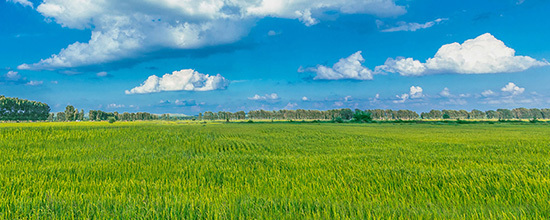
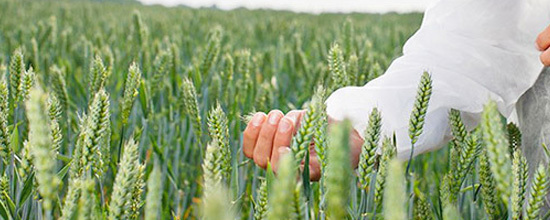


 LANGUAGE
LANGUAGE